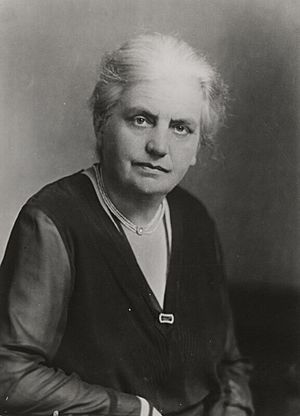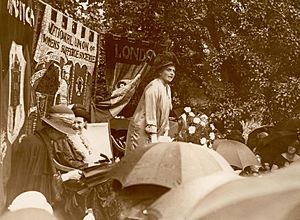Eleanor Rathbone facts for kids
Quick facts for kids
Eleanor Rathbone
|
|
|---|---|
 |
|
| Member of Parliament for Combined English Universities with Martin Conway 1929–1931 Reginald Henry Craddock 1931–1937 Thomas Edmund Harvey 1937–1945 Kenneth Martin Lindsay 1945— |
|
| In office 30 May 1929 – 2 January 1946 |
|
| Prime Minister | Stanley Baldwin |
| Preceded by | Alfred Hopkinson and Martin Conway |
| Succeeded by | Henry Strauss and Kenneth Martin Lindsay |
| Personal details | |
| Born |
Eleanor Florence Rathbone
12 May 1872 London, England |
| Died | 2 January 1946 (aged 73) London, England |
| Political party | Independent |
| Parents | William Rathbone VI Emily Lyle |
Eleanor Florence Rathbone (born May 12, 1872 – died January 2, 1946) was an important British politician. She was an independent Member of Parliament (MP). Eleanor Rathbone worked hard for many years. She fought for family allowances and women's rights. She was part of the well-known Rathbone family from Liverpool.
Contents
Eleanor Rathbone's Early Life
Growing Up and Education
Eleanor Rathbone was the daughter of William Rathbone VI. He was a social reformer. Her mother was Emily Acheson Lyle. Eleanor grew up in Liverpool, England. Her family always encouraged her to care about social issues. Their family motto was: "What ought to be done, can be done."
Eleanor went to Kensington High School in London. Later, she attended Somerville College in Oxford. She studied subjects like Roman History and Moral Philosophy. Eleanor was very dedicated to her studies. She did not spend much time on social activities.
Starting Her Work
Because she was a woman, Eleanor could not get an Oxford degree at that time. So, she traveled to Ireland to get a degree from Trinity College Dublin. After Oxford, Eleanor worked with her father. They looked into social and industrial conditions in Liverpool. They also spoke out against the Second Boer War.
In 1903, Eleanor published a report. It was about the working conditions at the Liverpool Docks. In 1905, she helped start the School of Social Science at the University of Liverpool. She taught public administration there. Today, the Eleanor Rathbone building at the university is named after her.
A Local Leader and Campaigner
Fighting for Women's Vote
In 1897, Eleanor became a leader in the Liverpool Women's Suffrage Society. This group worked to get women the right to vote. In 1909, she was elected to the Liverpool City Council. She served as an independent member until 1935.
Eleanor wrote articles for The Common Cause. This was a magazine for women who supported voting rights. She worked with other women, like Alice Morrissey. They helped women from different backgrounds work together in Liverpool. In 1913, she co-founded the Liverpool Women Citizen's Association. This group encouraged women to get involved in politics.
Supporting Families During Wartime
When the First World War began, Eleanor helped organize support for soldiers' families. She created the Town Hall Soldiers' and Sailors' Families Association. This group helped wives and children of soldiers. Today, it is known as SSAFA, a charity for armed forces families. Eleanor also started the "1918 Club" in Liverpool. It is one of the oldest women's discussion groups still meeting today.
Pushing for Family Allowances
From 1918 onwards, Eleanor argued for family allowances. These payments would go directly to mothers. She also spoke out against violence in Ireland. She played a key role in making sure women were included in the 1918 Representation of the People Act. This law gave many women the right to vote.
In 1919, Eleanor became the president of the National Union of Societies for Equal Citizenship. This group worked for equal rights for women. She also campaigned for women's rights in India. In 1922, she ran for Parliament but was not elected.
In 1924, Eleanor wrote a book called The Disinherited Family. She argued that women depended on men financially. This was because men's wages were meant to support families, no matter how many children they had. She also showed how rules about insurance made it harder for married women to get unemployment benefits and health insurance.
A National Politician in Westminster
Joining Parliament
Eleanor Rathbone ran for Parliament as a feminist. She said she was standing "as a woman." She believed women's unique experiences were needed in the House of Commons. In 1929, Eleanor became an independent MP for the Combined English Universities.
During the Great Depression, she fought for cheap milk and better support for children of unemployed parents. In 1931, she helped stop a plan to remove university seats in Parliament. She was re-elected in 1935.
Speaking Out Against Injustice
Eleanor understood the dangers of Nazism in Germany. In the 1930s, she joined the British Non-Sectarian Anti-Nazi Council. This group worked to support human rights. In 1934, she led the Children's Minimum Committee. This group wanted to raise awareness about how little money poor families had for their children's food.
In 1936, she warned about the Nazi threat to Czechoslovakia. She also supported Britain preparing for war. She wrote about this in Manchester Guardian newspaper.
Eleanor was a strong critic of appeasement. This was the policy of giving in to Hitler to avoid war. She spoke out against Britain's inaction when Hitler sent troops into the Rhineland. She also criticized the Italian conquest of Abyssinia and the Spanish Civil War. She even tried to hire a ship to help people escape danger in Spain.
Her determination was so strong that some government officials would try to avoid her! She supported the views of Winston Churchill and Clement Attlee. However, she earned the dislike of Neville Chamberlain.
In 1936, Eleanor supported Leon Trotsky's right to safety. She signed a letter calling for an investigation into the Moscow Trials. She believed women had a unique contribution to make in politics. But she also said that women's contributions would not be "utterly different" from men's.
On September 30, 1938, Eleanor spoke out against the Munich Agreement. She pushed Parliament to help Czechoslovaks. She also urged them to allow German, Austrian, and Jewish refugees into Britain. In late 1938, she set up a committee to help individual refugees. During World War II, she often challenged the government. In 1942, she pushed them to share information about the Holocaust.
Eleanor Rathbone's Personal Life
After the First World War, Eleanor bought a house in London with her friend Elizabeth Macadam. Elizabeth was also a social worker. They shared the house until Eleanor's death in 1946.
Eleanor Rathbone was related to the actor Basil Rathbone. Her nephew, John Rankin Rathbone, was also a Conservative MP. After he died in the Battle of Britain, his wife Beatrice became an MP. Her great-nephew Tim Rathbone was also a Conservative MP.
Her great-niece, Jenny Rathbone, is a Labour politician. She was elected to the National Assembly for Wales in 2011.
Eleanor Rathbone's Legacy
In 1945, the year before she died, Eleanor Rathbone saw her dream come true. The Family Allowances Act became law. This law provided payments to families with children.
In 1986, a blue plaque was put up for her in London. It is on Tufton Court, where she lived. Her name and picture are also on the base of the statue of Millicent Fawcett in Parliament Square, London. This statue was unveiled in 2018.
The University of Liverpool has an Eleanor Rathbone Building. It houses the School of Law and Social Justice and the Department of Psychology. It also has the Eleanor Rathbone Theatre. Edge Hill University has a student hall of residence named Eleanor Rathbone. This honors her work as a social reformer.
Archives
Eleanor Rathbone's papers are kept at the University of Liverpool's Special Collections & Archives. Other papers are held at The Women's Library at the Library of the London School of Economics.
| Parliament of the United Kingdom (1801–present) | ||
|---|---|---|
| Preceded by Sir Alfred Hopkinson and Sir Martin Conway |
Member of Parliament for the Combined English Universities 1929–1946 |
Succeeded by Henry Strauss and Kenneth Martin Lindsay |
See also
 In Spanish: Eleanor Rathbone para niños
In Spanish: Eleanor Rathbone para niños




